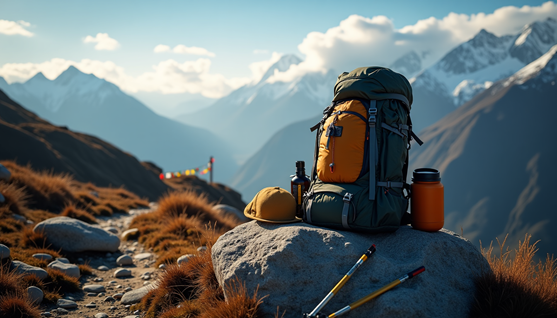Essential Gear Guide: Tips to Prepare for Your Trekkar India Adventure

Imagine this: You’re midway through an exhilarating mountain ascent when it hits you – that crucial item you forgot could have transformed your journey from challenging to comfortable. As seasoned trek leaders across diverse landscapes, we at Trekkar India have learned a vital lesson: a meticulously planned packing list is the cornerstone of an extraordinary adventure.
Crafting the ideal trekking inventory goes far beyond randomly stuffing gear into a backpack. It’s a nuanced process that adapts to the ever-changing variables of your expedition – the seasons, trip duration, terrain intricacies, and geographical nuances. Our wealth of experience has culminated in a comprehensive guide that flexes to meet these diverse needs.
Join us as we delve into the essentials of a successful trekking adventure. From the science of layered clothing to critical safety equipment, from region-specific gear to personal necessities, we’ll equip you with the knowledge to prepare for your next outdoor odyssey.
Let Trekkar India and our Essential Gear Guide Tips help you in transforming your upcoming expedition from a mere trek into an unforgettable adventure.
Trekkar India Essential Gear Guide
Customizing Your Packing List
Our experience shows that customizing a trekking packing list works differently for everyone. Let’s see how you can adapt your gear to various scenarios.
Season-specific requirements
Understanding weather patterns and temperature changes helps create the perfect seasonal packing list. Summer treks need lightweight, breathable gear that offers good sun protection. Here’s what each season calls for:
- Summer (June-August): Quick-drying synthetic clothing, waterproof boots, and gaiters to handle muddy trails
- Autumn (September-November): Moisture-wicking base layers plus insulating layers that adapt to temperature changes
- Winter (December-February): Insulated waterproof boots paired with heavyweight insulating layers
Trek duration considerations
Your trek’s length shapes your pack size and gear choices. Treks lasting more than seven days without resupply points just need a larger capacity backpack . A 60-70L pack works well for shorter treks, since bigger packs often add unnecessary weight.
Terrain-based adaptations
Each terrain type calls for specific gear changes. High-altitude treks need proper insulation and emergency gear. Long sleeves and pants with built-in insect repellent work best in brushy woodlands . Desert areas need extra water capacity and sun protection. Tropical zones work better with quick-drying, breathable materials.
Note that successful packing depends on anticipating weather conditions and knowing your trail conditions. Updated weather forecasts and trail reports should guide your final packing choices.
Essential Clothing Layers
Layering serves as the life-blood of our trekking comfort system. Our experience at Trekkar India shows that understanding each layer’s science makes a significant difference to your trek’s success.
Base layer selection guide
Your base layer acts as your first defense against discomfort. This layer should fit snugly against your skin to move moisture away effectively . You can choose between:
- Synthetic materials: Quick-drying and more durable
- Merino wool: Better temperature regulation and natural odor resistance
- Synthetic-wool blends: Combining durability with comfort
Insulation layer options
The insulating layer works as our heat-retention powerhouse. The efficiency of this layer determines your warmth during rest breaks. Fleece or down materials make optimal insulation choices, depending on your conditions. Fleece retains its insulating properties even when damp, while down provides superior warmth-to-weight ratio .
Outer shell requirements
Our experience leading treks in a variety of terrains has taught us that your outer layer must balance waterproofing with breathability. The best shells need taped seams and waterproof zipper systems . Our tested shells deliver multiple layers of protection and maintain breathability, even with their waterproof nature.
Your layers should work together harmoniously. Materials need to complement each other’s properties – your base layer’s wicking ability must match your mid-layer’s breathability. The outer shell should protect without compromising the system’s overall performance.
Personal Care and Safety
Safety can make or break any trek. Our experience shows that good preparation turns potential emergencies into manageable situations. Here’s a detailed breakdown of safety and personal care items every trekker needs in their backpack.
Hygiene supplies checklist
Good hygiene on treks protects your health beyond just comfort. Biodegradable products help protect the environment while keeping you clean . Here’s what you need:
Essential Items Purpose Unscented hand sanitizer Regular hand cleaning Biodegradable soap Personal washing Microfiber washcloth Multiple cleaning uses Compressed wipes Space-saving cleaning Emergency gear must-haves
Remote locations demand proper emergency preparation. An emergency heat-reflecting blanket provides reliable protection with a 4.6 out of 5-star rating . Satellite devicesbecome your lifeline when cell service disappears .
Note that proper training complements your gear. A first aid course builds confidence before you start challenging treks .
Region-Specific Requirements
Each terrain type just needs its own unique packing approach. Our years of experience in terrains of all types have helped us develop specialized gear recommendations for every environment.
High-altitude considerations
High elevations require proper acclimatization gear. Daily temperatures swing wildly – from below freezing (32°F/0°C) to above 85°F/29°C . Our high-altitude essentials include:
- Layered clothing for rapid temperature changes
- UV protection (the sun’s rays are stronger at elevation)
- Navigation tools with offline capabilities
Tropical trek necessities
Tropical environments make moisture management and sun protection vital. The humidity makes each step feel like walking through molasses . Here’s what we suggest:
Time of Day Temperature Gear Focus Morning Cool Light layers Midday Hot & Humid Sun protection Evening Moderate Moisture-wicking Desert trekking specifics
Desert environments bring their own unique challenges with extreme temperature variations. Temperature swings can reach up to 30 degrees between day and night . Your essential gear should include:
- Wide-brimmed hat and neck protection
- Salt tablets or electrolyte powder for hydration
- Collapsible water containers for reliable water sources
Note that weather forecasts should guide your final packing choices. A trek’s success in these environments depends on having the right gear that matches each region’s specific challenges.
Conclusion
The right trek preparation can turn your adventure into an unforgettable experience instead of a tough ordeal. At Trekkar India, our detailed packing approach takes care of every part of your experience. We pack the right clothing layers and bring gear that matches the region. Small details make a big difference. Your trek’s success depends on choosing the right base layer material and carrying the proper emergency supplies.
Your packing list must match what your specific trek needs. Think over things like the season, how long you’ll be out, the terrain, and where you’re going. When you make smart choices about clothing layers, safety gear, and personal items, you build a strong foundation for your expedition.
Note that successful trekking needs both quality gear and the skills to use it right. Our experience proves that full preparation and good equipment help you tackle unexpected challenges with confidence. Plan ahead, test your gear before you head out, and you’ll be all set for the adventure waiting on the trail.


